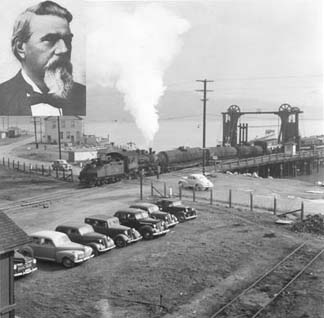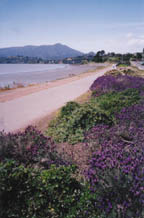
The Tiburon Issue
Tiburon’s not hard to love, set like it is
on the tip of the Tiburon Peninsula overlooking Raccoon Strait, Angel Island,
and San Francisco. The surprise here is the strong sense of place. The town is
very much lived in by its residents, and the experience is very real. Many
people come to Tiburon to enjoy the beautiful restaurants along the waterfront.
The perfect getaway, its only 6 miles over the water from the city, yet it is a
different world-highly scenic and rich in heritage. In Tiburon’s not so
distant past, railroad tracks and a ferry terminal made up much of what is now
downtown. This was the empire of Peter Donahue, a profoundly driven man who
started Union Iron Works, the first foundry in gold rush-era San Francisco. He
produced many ships and locomotives before bringing to Tiburon his San Francisco
and North Pacific Railroad-complete with ferry service from San Francisco and a
rail line from Tiburon to San Rafael. By 1885, the daily schedule included 6
round-trip train and ferry connections between San Francisco and San Rafael with
stops north to Cloverdale.
 |
| Tiburon was the empire of
Peter Donahue. |
The SF&NP Railroad competed with John
Doherty’s North Pacific Coast Railroad in Sausalito. In the heyday of the
local lines, it cost 50 cents round-trip from San Francisco to San Rafael
whether you went with Donahue’s line through Tiburon or Doherty’s line via
Sausalito. The spirited local lines thrived on the competition, and the rival
ferries would race to the San Francisco dock. Once in 1886, Sausalito’s San
Rafael and Donahue’s Tiburon, collided near the San Francisco Ferry
building, badly damaging the superstructure of the San Rafael, but
breaking only a window on the Tiburon. Imagine the raucousness of
ferryboats dueling for the speed. Racing was not officially endorsed under
either management, but it had been announced that any captain caught losing to a
Donahue ferry would be given double the usual five demerits dealt to a captain
caught racing.
In an different context, the race of speed
lives on for the ferries serving Tiburon and Sausalito today. In an effort to
increase ridership by enticing commuters, the Sausalito fleet introduced a
faster boat. Not to be outdone, the Tiburon fleet followed suit, only to find
that some Tiburon commuters are more interested in their quality time onboard.
Promoters of the slow ride, a group known as the fantail club, was
concerned that the fast boat (20 minute crossing) left no time for a second
cocktail. The slow boat (30 minute crossing) was put back on the schedule to
meet the demand. If you ride the slow boat to Tiburon, you may find them rolling
dice at the bar to determine who "wins" the honor of buying the round
for riding members. Dick Otter, a Belvedere stock broker whose been riding since
1968, was out of the dice game with a high roll, and kind enough to explain for
me the club rituals. The back of Dick’s membership card distinguishes the
fantail club as the "oldest established permanent floating commute
club." Members agree to: "promote the ferryboat as the only way to
commute," and to "smile at all strangers who ride the ferry."
Meanwhile, Paul Keating, Tom Freilberger, Doug O’Conner and Jack Brooks
continue to roll the dice until each (except ultimately Paul) rolls out. Paul
buys the round. "Now we go topside" Dick tells me. Fantail club
members have a
 |
| The Tiburon bike path Photo by
Nancy Salcedo |
requirement for membership that they be shat upon by a seagull
while on the fantail of the boat. Dick informs me that this usually occurs when
the herring run. The props flip the fish up, and the gulls follow. After riding
the ferry to Tiburon on such a fine evening, I decide fantail clubbers’ve got
their priorities in life well figured out.
But, what happened to the Tiburon and
other tales? The Tiburon, powered by an engine Donahue built in his Union
Iron Works, was the first ferry built in Tiburon. It was the star of the line
until it was outperformed by Donahue’s new ferry, the Ukiah . Obsolete,
the Tiburon was retired, served as a dormitory along the Tiburon Wharf in
1922 for railroad strikebreakers, and was later sold for scrap. Also built at
Tiburon, and so named when the Donahue line extended north to Ukiah in 1890, the
Ukiah was the largest ferry ferryboat in the world at the time. The Ukiah
was rebuilt and renamed the Eureka in 1923, when it ran between Sausalito
and San Francisco until 1941, and then between San Francisco-Oakland until 1957.
You can now visit the Eureka at the San Francisco Maritime State
Historical Park in San Francisco. Not until 1962 did Tiburon see direct ferry
service again, thanks to a push from the Belvedere Tiburon Conservation League
in an effort to ease traffic congestion and rejuvenate the waterfront.
CONTINUE